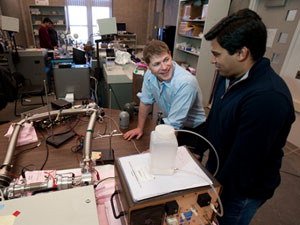Mechanical engineering professor measures the "air up there"

There’s an unseen world of very small particles,” says Chris Hogan. “It includes nature-made particles—which have been around for a long time—and other things that we’ve introduced.”
The existence of these very small particles has been realized only in the past century. Hogan is a mechanical engineer on the trail of nanoparticles—clusters of molecules—specifically those suspended in air and other gases.
People have been spending time next to fires for millennia, he points out, and that means air full of nanoparticles. Production of aerosol nanoparticles accelerated during the Industrial Revolution and continues today.
“I’m asking, how do we measure their impact on human health?” he says. “What’s their effect on our surroundings?”
Hogan is determined to find out. His approach spans the fields of mechanical engineering, chemistry, and materials science. Because his work is highly original with such a strong potential to advance basic science related to many critical questions, he was named a McKnight Land-Grant Professor for 2011-13.
In the lab one afternoon, he and graduate student Vinay Premnath worked with a mass spectrometer, installing an ionization source. The task is to ionize the nanoparticles in a gas, giving them a positive charge.
“We have to give the nanoparticles a charge so we can see them,” Hogan explains with a smile. “Charging something up is like putting on our very-small glasses.”
Hogan’s Nanoparticle Technology Lab is a workshop buzzing with activity. He moves from bench to bench with an animated intensity, asking questions and working out processes. The sheer number of researchers he has been able to attract and support in less than two years at the University of Minnesota is unusual—six graduate students, three or four undergraduates at any given time, and a postdoctoral researcher. A Ph.D. student came from Vienna for two and a half months as a visiting researcher.
In addition to supervising work in the lab every day and writing most afternoons—Hogan has already published more than 30 articles—this semester he’s teaching Mechanical Engineering 3332, fluid mechanics, to a class of 140 undergraduates, spending about six hours a day on the course. In his office, he keeps a constant eye on his laptop to respond immediately to students’ questions.
Hogan was a student himself only three years ago. Coming out of high school strong in math and science, he got a job as an undergraduate research assistant for a mathematician doing research in plant biology, measuring the mass of things.
“A lot of times you learn by doing, and then you learn why you’re doing it,” he says. “That work also taught me the interdisciplinary nature of science. We shouldn’t necessarily group topics into biology and physics and these separate disciplines.”
During a summer research experience for undergraduates at Washington University, Hogan learned about research on aerosol nanoparticles. Before the summer was over, he was hooked and soon returned to St. Louis for his Ph.D. He won a National Science Foundation grant in his second year.
After a postdoctoral position at Yale, Hogan chose Minnesota because of the 40-year history and reputation of the Particle Technology Laboratory as well as the strength of the College of Science and Engineering.
“It’s an outstanding university,” he says simply. He joined the faculty as the Benjamin Mayhugh Assistant Professor and proceeded to operate like a dynamo in every sphere, from teaching to fund-raising.
“On Monday I’m a morning person and by Friday I’m a night person,” he admits with a laugh.
With the McKnight Land-Grant Professorship, Hogan will strengthen his lab.
“It provides academic freedom that most people don’t get this early in their careers,” he says. “It allows me to fund a Ph.D. student independent of a research grant with a specific end goal. Not everything speaks to a funding agency, especially some of the basic science.”
With Hogan’s help, more of the unseen world will become visible.
